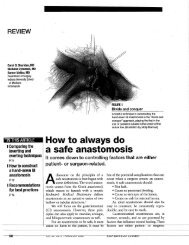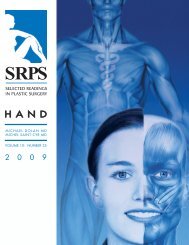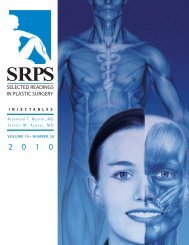Craniofacial Anomalies, Part 2 - Plastic Surgery Internal
Craniofacial Anomalies, Part 2 - Plastic Surgery Internal
Craniofacial Anomalies, Part 2 - Plastic Surgery Internal
You also want an ePaper? Increase the reach of your titles
YUMPU automatically turns print PDFs into web optimized ePapers that Google loves.
Fig 10. Cranial sutures in the human fetus. Premature closure<br />
produces growth restriction perpendicular to the line of the<br />
suture and compensatory overgrowth parallel to it.<br />
Scaphocephaly (dolichocephaly) is due to premature<br />
fusion of the sagittal suture. Features of sagittal<br />
synostosis include a palpable ridge overlying the sagittal<br />
suture, decreased biparietal diameter, and elongation<br />
of the skull in the anteroposterior dimension.<br />
Significant frontal and occipital bossing are commonly<br />
noted. The appearance resembles a boat or “scaphe.”<br />
Plagiocephaly stems from the Greek word meaning<br />
“crooked head”, and is an asymmetrical deformity.<br />
It may be anterior or posterior. Two etiological<br />
variants must be distinguished – deformational<br />
and synostotic.<br />
Posterior plagiocephaly is usually positional and a<br />
result of the child lying predominately on his/her<br />
back. It produces a classic parallelogram skull<br />
deformity. 139 The incidence has increased with the<br />
recommendation by the American Academy of<br />
Pediatrics to lay infants on their backs to reduce the<br />
risk of sudden infant death syndrome (SIDS). 140,141<br />
Treatment of positional plagiocephaly depends on<br />
SRPS Volume 10, Number 17, <strong>Part</strong> 2<br />
the severity of the deformity and often requires helmet<br />
therapy for correction in severe cases. However,<br />
large studies have shown little difference in<br />
outcome between helmet therapy and consistent<br />
repositioning of the infant off the flat spot in mild to<br />
moderately severe cases. 141,142<br />
Posterior synostotic plagiocephaly can also result<br />
from unilambdoid synostosis. Unilambdoid synostosis<br />
is a very rare entity.<br />
Brachycephaly is the result of bicoronal synostosis<br />
and is characterized by anteroposterior shortening<br />
of the skull. The lower part of the forehead and<br />
supraorbital bar are retropositioned. This is the<br />
characteristic head shape deformity that accompanies<br />
Apert and Crouzon syndrome, and in these<br />
cases it is believed to be due to abnormalities that<br />
extend into the cranial base, causing the associated<br />
facial deformities of exorbitism and maxillary retrusion.<br />
Posterior brachycephaly is unusual but can<br />
be the external manifestation of bilateral lambdoid<br />
suture synostosis.<br />
Turricephaly (towering head deformity) is characterized<br />
by excessive skull height and a vertical forehead.<br />
This deformity is typically an untreated<br />
brachycephaly where compensatory expansion leads<br />
to an increasing vertical height to the cranium. Children<br />
with Apert syndrome have a particular tendency<br />
toward turricephaly.<br />
Oxycephaly is a pointed head. The forehead is<br />
retroverted and tilted back in continuity with the<br />
nasal dorsum. Oxycephaly is usually due to fusion of<br />
multiple sutures.<br />
When multiple sutures are involved, head shapes<br />
are more variable and the distinctions blur. In these<br />
cases the specific sutures involved should be named<br />
when describing the deformity. The kleeblattschadel<br />
or cloverleaf skull deformity results from pansutural<br />
synostosis, and usually requires early, aggressive treatment<br />
to prevent cerebral compromise.<br />
<strong>Craniofacial</strong> Growth<br />
The cranium is made up of the neurocranium,<br />
which includes the chondrocranium of the skull base<br />
and the membranous bone of the calvarium, and<br />
the viscerocranium, which forms the membranous<br />
bones of the face. The various areas of the<br />
craniomaxillofacial skeleton grow by very different<br />
methods. The cranial sutures are skeletal joints of<br />
the syndesmosis type as well as being sites of osteo-<br />
13






